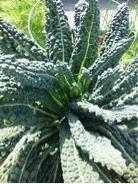Kale
-
Scientific NameBrassica oleracea var. acephala
-
General InformationKale comes in edible and ornamental varieties. Ornamental or flowering kale is grown for decorative leaves. Edible, or salad, kale is a super nutritious, cool-season, fast-growing relative of cabbage that is eaten raw or cooked. Within each type there are many sizes, shapes, and colors. Kale grows beautifully in Marin.
 Photo: Linda Varonin
Photo: Linda Varonin -
When to Plant
Direct seed: March through April (weather depending, maybe February and May) and then again in September (maybe August and October). If starting seeds indoors, allow six weeks before transplanting. Kale can be started from seed in place or set out as starts for earlier results. The seeds are vigorous sprouters, springing from the ground at a radish-like rate.
Transplant: March through April (maybe May), September through October (maybe August in cooler climates).
Don’t plant too late in the fall or the plants may not fully mature and then will bolt in the spring.
-
Planting
Kale is a cool season vegetable that prefers a sunny location. Incorporate plenty of organic matter and a complete fertilizer into the area before planting. Plant seeds a quarter-inch to a half-inch deep. Thin seedlings or transplant kale 12 to 18 inches apart, with rows two feet apart. Plant out four to five weeks before the last frost. Kale tastes best when plants grow rapidly and mature before the heat of summer or after fall frosts occur.
For fall kale, select early maturing cultivars and plant 50 to 75 days before the anticipated maturity date. The maturity date should be about two to three weeks after the first fall frost. Plants can be left in the garden throughout the winter to supply greens out of season. High summer temperatures reduce growth, decrease quality, and cause bitter or other undesirable flavors to develop.
-
Soil Requirements
Kale prefers fertile, well-drained soil rich in organic matter.
-
Water Requirements
Water kale deeply and infrequently while trying to maintain even soil moisture. About one to two inches of water are required per week. Use drip irrigation if possible to conserve water. Apply mulch to conserve soil moisture and reduce weeds. Moisture fluctuations will cause leaves to become tough and develop undesirable flavors.
-
Fertilizing
Provide ample nitrogen in the early growth stages, as kale is a heavy feeder. Alfalfa pellets are a great organic nitrogen source.
-
Pollination
Kale is consumed before pollination occurs. Once it forms flowers and stems (bolt) it is usually bitter and tough. Kales are self-incompatible and exclusively cross-pollinating. They are pollinated by insects. Isolation distances must take into account the presence of insect pollinators and distances of other nearby floral sources of compatible cultivated and wild species.
-
Harvesting
Depending upon variety, harvest kale 65 to 75 days after germination. Pick in the morning. The lower leaves can be cut as early as 30 days for use raw in a salad. As the plant matures, pick the lower leaves when they are from five to eight inches long. In general, smaller leaves are more tender. Then entire plant may be harvested as well.
-
Storage
Kale wilts quickly. After harvest, wash and store in the refrigerator in the crisper drawer. Kale can be stored up to two weeks at 32°F and 95% relative humidity. Many gardeners leave kale growing in the garden throughout the winter and use it fresh.
-
Good Varieties for Marin
All varieties of kale grow well in Marin.
'Lacinato' (aka dinosaur or Tuscan) kale is approximately 18 inches tall with beautiful, blue-green crinkly leaves. It is a staple in Italian cooking.
'Red Russian' and Siberian kales (Brassica napus) are well-known and widely available. The Russian-Siberian kales are typically more tender and mild flavored than the oleracea kales and can be put into a salad when the leaves are young.
-
Helpful Tips
Ornamental kale is technically the same genus (Brassica) and species (oleracea) as the more familiar broccoli, cabbage, and other cole crops. It is also genetically the same as kale grown in vegetable gardens as an edible green. Ornamental kales were developed by plant breeders from edible kale varieties by selecting plants with unique foliage colors. Ornamental kales are still edible, but they are mostly used for garnishing cooked dishes or additions to seasonal color areas of a landscape because of their gorgeous color.
Use row covers to protect seedlings and transplants from frosts and insect pests.
-
Common Problems
Cabbage worms and aphids. Cool weather often deters infestations, but be alert and use insecticidal soap when necessary. Blast aphids off with the hose or hand pick worms that refuse to give it up for the winter.
-
Pests- Diseases & More
Learn more about growing kale.

